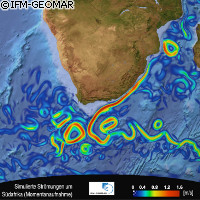Roaring forties influencing Atlantic Gulf Stream
An international team of oceanographers investigating the Southern Ocean has discovered that currents of the Southern Ocean are impacting those of the Atlantic Ocean. Their findings are published online in the journal Geophysical Research Letters. In times past, sailors rounding the Cape of Good Hope and the more southerly Cape Agulhas would head south instead of continuing east. In so doing they would encounter the strong westerly winds known as the 'Roaring Forties', found below the 40th latitude South. These strong winds would fill their sails and almost halve their travelling time on their journey to Australia or the Indies. The researchers focused on this latitude and confirmed climate model predictions indicating an increase in ocean temperature and a decrease in salinity. However, they did not note any change in the currents. 'Our results point to one important thing: eddies which are currently not resolved in climate models might be the key process in controlling the transport of the Antarctic Circumpolar Current,' explained Professor Claus Böning from the Leibniz Institute of Marine Sciences (IFM-GEOMAR) in Germany. The scientists studied the Agulhas Current, which, like the Gulf Stream, is one of the strongest currents in the world's oceans. The Agulhas Current circles the Southern Ocean, bringing warm and salty water from the tropical Indian Ocean along South Africa's east coast; when it reaches a point to the southwest of Cape Town, it turns back into the Indian Ocean. These so-called 'Agulhas Rings' carry extra heat and salt into the South Atlantic, making this a key region for the whole Atlantic Ocean. 'Surprisingly, one can follow the influence of the Agulhas Current right up to the North Atlantic Ocean,' said Dr Arne Biastoch of IFM-GEOMAR. 'This has important consequences for observational programmes in the North Atlantic that attempt to determine the much feared long-term, climatic changes in the Gulf Stream system.' The researchers found that normal year-to-year changes in the formation of Agulhas Rings result in an increase in the flux of warm water across the equator from the South to the North Atlantic Ocean in just a few years. This impact was previously unknown. The research was part of the Argos Programme, an international collaboration that has created a worldwide network of robotic probes that provides real-time data for use in climate, weather and oceanographic research. Every 10 days buoys measure temperature and salinity profiles in the upper 2,000 metres of the seas. The measurements are transmitted to land stations via satellite. 'For this study about 52,000 profiles of more than 600 Argo-drifters in the Southern Ocean were used and compared with historic ship measurements,' explained oceanographer Astrid Dispert of IFM-GEOMAR. The study also made extensive use of the archives of the Australian marine research centre in Tasmania. For Professor Martin Visbeck, access to Argos was a major boon. 'This is a quantum leap in the field of ocean observations, which, together with high resolution modelling, gives us new insights about long-term changes in the ocean,' he said. For Professor Böning, there is still a long road ahead for the researchers. 'Further investigations have to show whether the results are robust. If confirmed, this would in one way be good news: Until now the Southern Ocean is the biggest oceanic sink for anthropogenic carbon dioxide and therefore a crucial regulator for the atmospheric carbon dioxide concentration. Climate models predicted a severe reduction in the Southern Ocean carbon dioxide uptake due to wind-forced changes in the current fields. Now, high-resolution models are needed to assess the role of the hitherto unresolved ocean eddies in the Southern Ocean's response to the progressive changes in the atmospheric conditions.'



